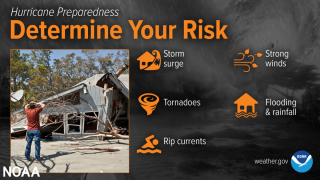Hurricane Preparedness

The North Beach Flood Committee wants you to be ready for hurricane season. Get the latest information on hurricane alerts and hurricane-related flood hazards from the National Weather Service at https://www.nhc.noaa.gov/.
A hurricane is a tropical cyclone that forms in the Atlantic Ocean, eastern Pacific Ocean, the Caribbean Sea, and the Gulf of Mexico. They are among the most destructive forces in nature. Hurricane season runs from June through November, peaking in early to mid-September, but hurricanes can happen any time. Prepare now so you can stay safe.
Hurricane Hazards
Hurricanes can be accompanied by hazards before, during and after the storm. Here’s a look at hurricane-related flood hazards.
- Storm surge is the abnormal rise of water generated by a storm's winds. This hazard is historically the leading cause of hurricane-related deaths in the United States. Storm surge and large battering waves can result in a large loss of life and cause massive destruction along the coast. Storm surge can travel several miles inland, especially along bays and rivers.
- Flooding from heavy rains is the second leading cause of fatalities from landfalling hurricanes. Widespread torrential rains associated with these storms often cause flooding hundreds of miles inland. This flooding can persist for several days after a storm has dissipated.
- Rip currents produced by a hurricane's strong winds can pose a significant hazard to coastal residents and mariners. These waves can cause deadly rip currents, significant beach erosion, and damage to structures along the coastline, even when the storm is more than 1,000 miles offshore.
For more information about Hurricane Hazards, please visit the National Hurricane Center for Hurricane Preparedness.
Hurricane Alerts
- Know the difference between a hurricane “watch” and “warning.”
- A hurricane watch means hurricane conditions (sustained winds of 74 miles per hour or higher) are possible in a stated area. Experts announce hurricane watches 48 hours before they expect tropical-storm-force winds (sustained winds of 39 to 73 mph) to start.
- A hurricane warning is more serious. It means hurricane-force winds are expected in a stated area. Experts issue these warnings 36 hours before tropical-storm-force winds are expected in the area to give people enough time to prepare for the storm.
- Listen for National Weather Service alerts on TV or radio or check for them online.
- For more information about hurricane watches and warnings, visit the National Hurricane Center’s Watches, Warnings, Advisories, and Outlooks page. If you hear that there is a hurricane watch or warning in your area, you must take action to prepare.
Take Action
- Get an Insurance Checkup
- Call your insurance company or agent and ask for an insurance check-up to make sure you have enough insurance to repair or even replace your home and/or belongings. Home and renters’ insurance doesn’t cover flooding, so you’ll need a separate policy for it.
- Flood insurance is available through insurance companies and the National Flood Insurance Program. Act now, as flood insurance requires a 30-day waiting period.
- Strengthen Your Home
- Secure all doors on your property. Remember that garage doors are the usually the most vulnerable.
Resources
- National Weather Service Hurricane Preparedness Week
- CDC Hurricanes & Other Tropical Storms
- National Flood Insurance Program coverage for flood damage that homeowner’s insurance won’t cover
- Flood Map Service Center for determining your flood risk
- National Storm Surge Hazard Maps to determine your vulnerability.
The Town of North Beach encourages all residents to review emergency procedures and create family plans as a way to proactively prepare in case of major coastal storms, hurricanes, localized flooding, etc. The town follows procedures and recommendations from the Calvert County Department of Public Safety. It is recommended that residents be prepared by becoming familiar with and utilizing online emergency preparedness resources offered through the county’s website and the Maryland Emergency Management Agency website.
- Calvert County Department of Public Safety
- Maryland Emergency Management Agency
- Town of North Beach Evacuation Routes

